The Facade Materials Market is estimated to be valued at USD 272.0 billion in 2025 and is projected to reach USD 565.8 billion by 2035, registering a compound annual growth rate (CAGR) of 7.6% over the forecast period.
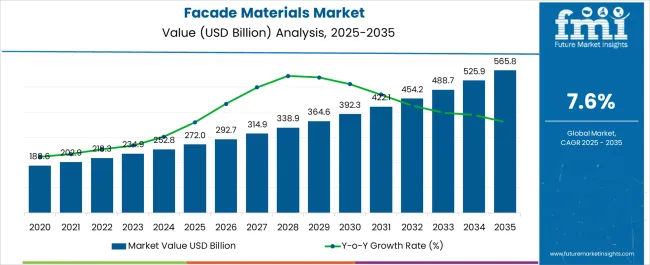
| Metric | Value |
|---|---|
| Facade Materials Market Estimated Value in (2025 E) | USD 272.0 billion |
| Facade Materials Market Forecast Value in (2035 F) | USD 565.8 billion |
| Forecast CAGR (2025 to 2035) | 7.6% |
The Facade Materials market is witnessing steady growth, driven by the rising demand for sustainable and high-performance building envelopes in both commercial and residential construction. Increasing focus on energy efficiency, environmental sustainability, and architectural aesthetics is encouraging the adoption of advanced facade materials. Facades are being designed to provide thermal insulation, weather resistance, and structural durability, while also meeting green building standards and reducing operational energy costs.
Technological innovations in material science, such as engineered wood composites, advanced coatings, and high-strength panels, are enabling facades to deliver improved performance and longevity. Growing investments in urban infrastructure, smart buildings, and environmentally conscious construction practices are further accelerating market expansion.
Regulatory emphasis on energy-efficient and low-carbon construction materials, along with increasing awareness of lifecycle cost benefits, is supporting the adoption of premium facade solutions As architects, contractors, and developers prioritize design flexibility, durability, and sustainability, the market is expected to continue its upward trajectory, driven by material innovation and evolving construction practices.
The facade materials market is segmented by material type, application, product features, end-user, and geographic regions. By material type, facade materials market is divided into Wood, Metal, Aluminum, Copper, Brass, Stainless Steel, Bronze, Glass, Ceramic, Plastic And Fiber, and Concrete. In terms of application, facade materials market is classified into Sustainable Façade and Dynamic Façade. Based on product features, facade materials market is segmented into Structural Integrity, Weather-Tightness, Thermal Insulation, Durability, Acoustic Insulation, and Safety And Security. By end-user, facade materials market is segmented into Residential, Commercial, and Industrial. Regionally, the facade materials industry is classified into North America, Latin America, Western Europe, Eastern Europe, Balkan & Baltic Countries, Russia & Belarus, Central Asia, East Asia, South Asia & Pacific, and the Middle East & Africa.
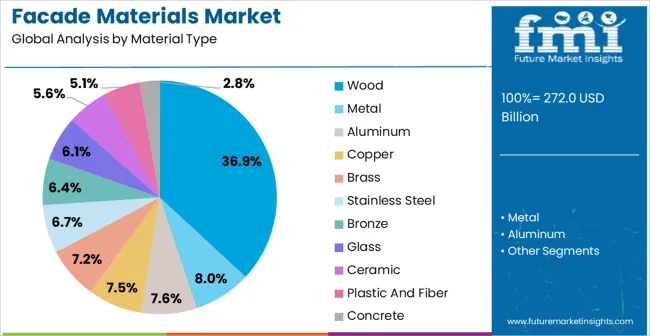
The wood segment is projected to hold 36.9% of the market revenue in 2025, establishing it as the leading material type. Growth in this segment is driven by the natural aesthetic appeal, sustainability, and adaptability of wood in facade design. Engineered wood products offer enhanced durability, dimensional stability, and resistance to environmental factors compared with traditional timber, supporting their adoption in modern architecture.
The ability to integrate wood with other materials and coatings for improved performance, such as weather resistance and fire safety, further strengthens its appeal. Sustainability credentials, including renewable sourcing and reduced carbon footprint, are increasingly important for green building certifications, encouraging architects and developers to select wood facades.
Maintenance requirements, long-term performance, and structural reliability are being enhanced through technological advancements in wood treatment and processing As energy efficiency, sustainable construction, and design flexibility remain priorities in the building industry, wood is expected to maintain its leadership among facade materials, supported by innovation and growing demand for high-quality sustainable construction solutions.

The sustainable façade application segment is expected to account for 55.6% of the market revenue in 2025, making it the leading application area. Growth is being driven by the increasing emphasis on energy efficiency, green building certification, and environmental sustainability in both commercial and residential construction projects.
Sustainable facades help reduce energy consumption through improved insulation, thermal performance, and natural light utilization, contributing to lower operational costs and carbon emissions. Advanced facade systems integrate renewable materials, intelligent shading, and high-performance coatings, enabling buildings to meet stringent regulatory requirements and environmental standards.
Demand is further fueled by rising awareness among developers and property owners regarding the long-term benefits of sustainable construction, including reduced maintenance, durability, and lifecycle cost savings As governments and regulatory bodies continue to promote sustainable building practices, the adoption of sustainable facades is expected to remain the primary driver of market growth, with continuous innovation in materials and design solutions strengthening its market position.
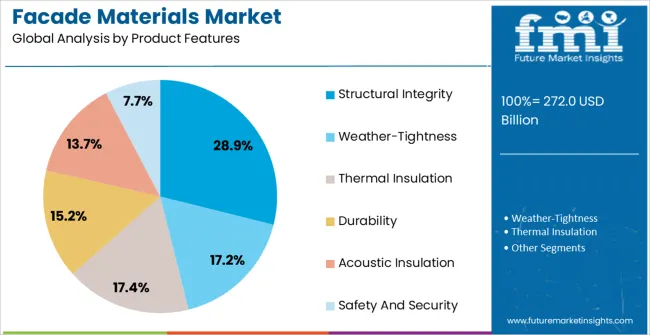
The structural integrity segment is projected to hold 28.9% of the market revenue in 2025, establishing it as the leading product feature. Growth in this segment is being driven by the critical need for facade materials that ensure long-term durability, safety, and resistance to environmental stresses such as wind, rain, and temperature fluctuations. Structural integrity is particularly valued in high-rise buildings, commercial complexes, and infrastructure projects where safety and compliance with building codes are paramount.
Advanced engineering, material reinforcement, and precision manufacturing techniques are enhancing the strength, rigidity, and performance of facade panels. Facade materials that combine structural integrity with aesthetic appeal and sustainability are increasingly preferred by architects and developers.
The ability to maintain performance under varying load conditions and weathering while reducing maintenance and replacement costs further strengthens market adoption As construction standards evolve and demand for safe, durable, and efficient building envelopes increases, structural integrity is expected to remain a key product feature driving the growth of the facade materials market.
FaCade Materials are the architectural materials that are used for increasing the aesthetics of a building. These constructional materials are usually used at the entrance part of the building. Besides just giving an aesthetic feel to the building, these materials can also be used for energy recreation.
Building façades can be manufactured using various materials including but not limiting to glass, fiber, cement, wood, solar panels and metal. Façade materials are more about edifice aesthetics and are of a great significance for the design of the same. These are not only used for high rising buildings and offices but also for decorating storefronts and residences. Façade materials have been in use since twelfth century and have been in development ever since then.
The most modern façade materials are being used for manufacturing dynamic façades which are responsive to natural and artificial simulations. For example, wind responsive dynamic façade in Brisbane car park terminal in Australia wherein the façade is made up of 250,000 suspended aluminum panels which make a fluidic appearance when natural wind flows through them without actually wasting any kind of energy.
Yet another modern example can be noted in the seasonal green dynamic façade in Portugal where the façade is designed in such a way that plantation can be grown on the exterior of building walls. Newer advancements and experiments are being made with the usage of façade materials.
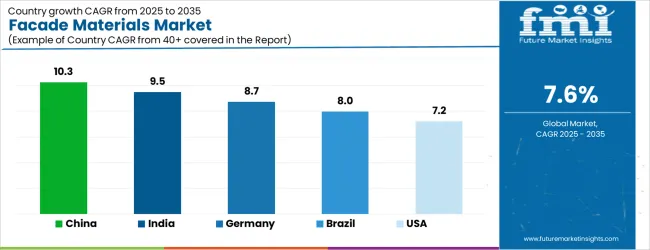
| Country | CAGR |
|---|---|
| China | 10.3% |
| India | 9.5% |
| Germany | 8.7% |
| Brazil | 8.0% |
| USA | 7.2% |
| UK | 6.5% |
| Japan | 5.7% |
The Facade Materials Market is expected to register a CAGR of 7.6% during the forecast period, exhibiting varied country level momentum. China leads with the highest CAGR of 10.3%, followed by India at 9.5%. Developed markets such as Germany, France, and the UK continue to expand steadily, while the USA is likely to grow at consistent rates. Japan posts the lowest CAGR at 5.7%, yet still underscores a broadly positive trajectory for the global Facade Materials Market. In 2024, Germany held a dominant revenue in the Western Europe market and is expected to grow with a CAGR of 8.7%. The USA Facade Materials Market is estimated to be valued at USD 97.8 billion in 2025 and is anticipated to reach a valuation of USD 97.8 billion by 2035. Sales are projected to rise at a CAGR of 0.0% over the forecast period between 2025 and 2035. While Japan and South Korea markets are estimated to be valued at USD 13.1 billion and USD 7.4 billion respectively in 2025.
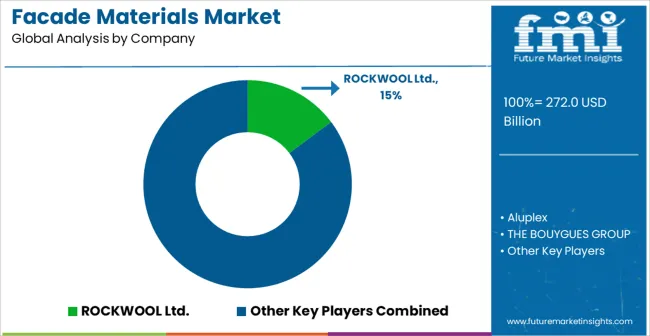
| Item | Value |
|---|---|
| Quantitative Units | USD 272.0 Billion |
| Material Type | Wood, Metal, Aluminum, Copper, Brass, Stainless Steel, Bronze, Glass, Ceramic, Plastic And Fiber, and Concrete |
| Application | Sustainable Façade and Dynamic Façade |
| Product Features | Structural Integrity, Weather-Tightness, Thermal Insulation, Durability, Acoustic Insulation, and Safety And Security |
| End-User | Residential, Commercial, and Industrial |
| Regions Covered | North America, Europe, Asia-Pacific, Latin America, Middle East & Africa |
| Country Covered | United States, Canada, Germany, France, United Kingdom, China, Japan, India, Brazil, South Africa |
| Key Companies Profiled | ROCKWOOL Ltd., Aluplex, THE BOUYGUES GROUP, Enclos Corp., EOS Framing Limited, Saint-Gobain Group, AFS International, Kingspan Group, Lindner Group, Fundermax, Josef Gartner GmbH, HansenGroup, and HOCHTIEF Aktiengesellschaft |
The global facade materials market is estimated to be valued at USD 272.0 billion in 2025.
The market size for the facade materials market is projected to reach USD 565.8 billion by 2035.
The facade materials market is expected to grow at a 7.6% CAGR between 2025 and 2035.
The key product types in facade materials market are wood, metal, aluminum, copper, brass, stainless steel, bronze, glass, ceramic, plastic and fiber and concrete.
In terms of application, sustainable façade segment to command 55.6% share in the facade materials market in 2025.






Our Research Products

The "Full Research Suite" delivers actionable market intel, deep dives on markets or technologies, so clients act faster, cut risk, and unlock growth.

The Leaderboard benchmarks and ranks top vendors, classifying them as Established Leaders, Leading Challengers, or Disruptors & Challengers.

Locates where complements amplify value and substitutes erode it, forecasting net impact by horizon

We deliver granular, decision-grade intel: market sizing, 5-year forecasts, pricing, adoption, usage, revenue, and operational KPIs—plus competitor tracking, regulation, and value chains—across 60 countries broadly.

Spot the shifts before they hit your P&L. We track inflection points, adoption curves, pricing moves, and ecosystem plays to show where demand is heading, why it is changing, and what to do next across high-growth markets and disruptive tech

Real-time reads of user behavior. We track shifting priorities, perceptions of today’s and next-gen services, and provider experience, then pace how fast tech moves from trial to adoption, blending buyer, consumer, and channel inputs with social signals (#WhySwitch, #UX).

Partner with our analyst team to build a custom report designed around your business priorities. From analysing market trends to assessing competitors or crafting bespoke datasets, we tailor insights to your needs.
Supplier Intelligence
Discovery & Profiling
Capacity & Footprint
Performance & Risk
Compliance & Governance
Commercial Readiness
Who Supplies Whom
Scorecards & Shortlists
Playbooks & Docs
Category Intelligence
Definition & Scope
Demand & Use Cases
Cost Drivers
Market Structure
Supply Chain Map
Trade & Policy
Operating Norms
Deliverables
Buyer Intelligence
Account Basics
Spend & Scope
Procurement Model
Vendor Requirements
Terms & Policies
Entry Strategy
Pain Points & Triggers
Outputs
Pricing Analysis
Benchmarks
Trends
Should-Cost
Indexation
Landed Cost
Commercial Terms
Deliverables
Brand Analysis
Positioning & Value Prop
Share & Presence
Customer Evidence
Go-to-Market
Digital & Reputation
Compliance & Trust
KPIs & Gaps
Outputs
Full Research Suite comprises of:
Market outlook & trends analysis
Interviews & case studies
Strategic recommendations
Vendor profiles & capabilities analysis
5-year forecasts
8 regions and 60+ country-level data splits
Market segment data splits
12 months of continuous data updates
DELIVERED AS:
PDF EXCEL ONLINE
Facade Market Size and Share Forecast Outlook 2025 to 2035
Nanomaterials Market Insights - Size, Share & Industry Growth 2025 to 2035
Tire Materials Market Insights – Size, Trends & Forecast 2025–2035
Solder Materials Market Size and Share Forecast Outlook 2025 to 2035
Sheath Materials Market Size and Share Forecast Outlook 2025 to 2035
Cathode Materials for Solid State Battery Market Size and Share Forecast Outlook 2025 to 2035
Exosuit Materials Market Size and Share Forecast Outlook 2025 to 2035
Stealth Materials and Coatings Market Size and Share Forecast Outlook 2025 to 2035
Battery Materials Recycling Market Size and Share Forecast Outlook 2025 to 2035
Battery Materials Market: Growth, Trends, and Future Opportunities
Optical Materials Market - Trends & Forecast 2025 to 2035
Circuit Materials Market Analysis based on Substrate, Conducting Material, Outer Layer, Application, and Region: Forecast for 2025 and 2035
Graphite Materials Market Size and Share Forecast Outlook 2025 to 2035
Building Materials Market Size and Share Forecast Outlook 2025 to 2035
Recycled Materials Packaging Market Size and Share Forecast Outlook 2025 to 2035
Magnetic Materials Market Growth - Trends & Forecast 2025 to 2035
Fluoride Materials Market
Packaging Materials Market Size and Share Forecast Outlook 2025 to 2035
Strapping Materials Market Size and Share Forecast Outlook 2025 to 2035
Smart Card Materials Market Size and Share Forecast Outlook 2025 to 2035

Thank you!
You will receive an email from our Business Development Manager. Please be sure to check your SPAM/JUNK folder too.
Chat With
MaRIA